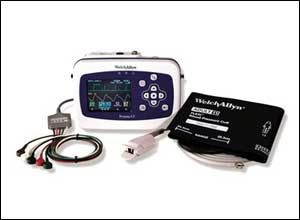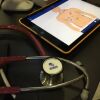 The Propak LT from Welch-Allyn |
The first electronic devices in EMS were defibrillators; now almost everything seems to have a computer chip in it. I remember when pulse oximeters first gained popularity. One of the biggest concerns about these devices back in the late ‘80s and early ‘90s was their reliability and durability. Initially, there were only one or two brands that would even hold up on the street.
Many providers, including myself, would frequently caution against relying on electronic devices. “They can fail when you need them most,” we would always say. However, many of our medical devices have improved in recent years as a result of rapid changes in the consumer products industry. Devices keep getting smaller, and batteries keep getting better. These improvements have been rapidly migrating into the medical field.
What once took 20 different parts and several large circuit boards to accomplish now can be done with a chip the size of your fingernail. Today, there is a huge selection of reliable and durable pulse oximeters along with many other types of medical electronic devices. It was not long ago that a pulse oximeter was the size of a lunch-box; now they are practically jewelry-sized.
The evolution of medical electronics in EMS has been rapid. Here are a few notable examples of developments made within the last year or two.
Non-invasive monitors
The effectiveness of non-invasive vital signs monitors was once comparable to randomly picking your daily lottery number. It took years to develop more reliable and accurate monitors. They can now alert you to dangerous changes in status earlier than ever before. However, this doesn’t mean we can let our manual sphygmomanometer gather dust. Using manual methods initially will help you become aware of conditions like an irregular pulse right away.
As oscillometry technology improved, so did non-invasive blood pressure monitoring products. The Propak LT from Welch-Allyn, soon to be marketed exclusively by Zoll, is an example of modern, compact BP monitors. It offers continuous monitoring of heart rate, 3- or 5-lead ECGs, SpO2, NIBP, and respiration. Another great example of miniaturized technology that has benefited our industry is the statMAP from CardioCommand, a new hand-held semi-automatic BP monitor.
Capnometry
Capnography has benefited greatly from improvements in both battery life and reliability, as shown in the new Capnocheck, from Smiths Medical / BCI. The Capnocheck is small enough to rest in the palm of your hand and can be carried with your intubation kit for rapid and accurate end-tidal CO2 confirmation of tube placement. Another outstanding example is the Nonin Lifesense, a much more full-featured capnometer.
Temperature Monitoring
We have also seen big gains made in temperature monitoring devices. A few of the more recent developments are the SureTemp Plus, the Covidien Filac 3000EZ, and the new DataTherm II from RG Medical Diagnostics. The DataTherm is a continuous temperature monitor with a 39” disposable probe. You just insert it into the esophagus like a simple NG tube to monitor actual core temperatures. As we learn more about the benefits of rapid patient cooling, this device should prove an invaluable tool.
Core Technology
Other EMS devices are benefiting from these rapid changes in computer chip technology. One of the most innovative is the Masimo Rainbow SET, which measures hemoglobin, oxygen content, carboxyhemoglobin, methemoglobin, pleth variability index, oxygen saturation, pulse rate and perfusion index. Masimo has also achieved enormous success with its Rad-57 Co-Oximeter, which measures both oxygen saturation and carbon monoxide.
The primary device that has benefited the most from technology advancement is the defibrillator. The modern portable defibrillator now does so much more than just shock. EMS providers have demanded that key monitoring features be built right into their primary defibrillator. The first defibrillator “add-on” was pacing, followed by event recording and time-stamp documentation. Then12-lead ECG capabilities became commonplace.
Soon Zoll will be offering a monitor/defibrillator that will includes the latest Masimo COHb technology. Physio-Control will soon release the hot new LifePak 15. It won’t be long before you can buy a defibrillator that can monitor central lines, blood pressure, and give real-time feedback on your chest compressions.
These are only a few of the sweeping changes made possible by advanced microcircuit design and modern electronics production methods. Our medical devices designed for EMS use keep getting smaller, more reliable, and more rugged. I am fond of telling EMS product manufacturers that if you leave any typical paramedic in a room with two steel balls for an hour, when you return you are likely to find one ball lost and the other one broken. It looks like these manufacturers are listening and developing much tougher medical electronic products that also have many new advanced features and capabilities.


